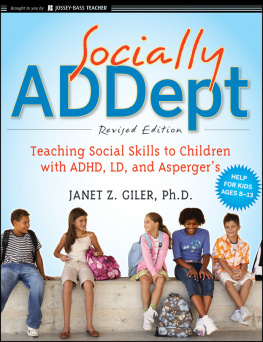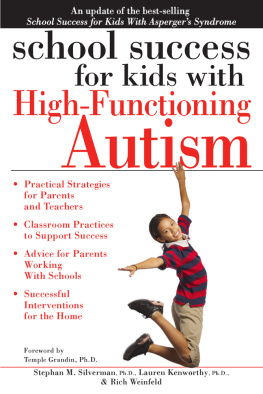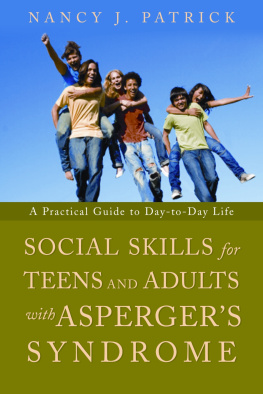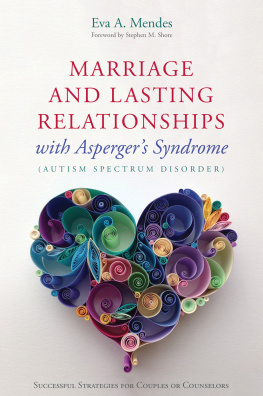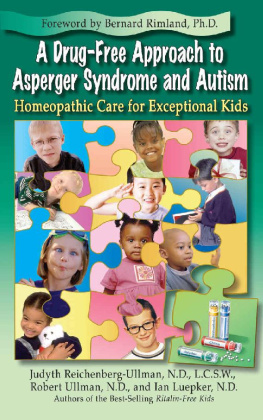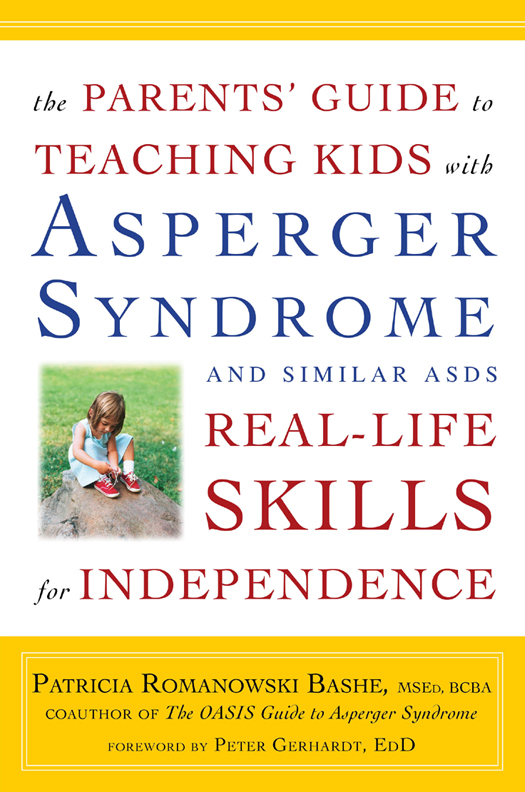Also by Patricia Romanowski Bashe
The OASIS Guide to Asperger Syndrome
(with Barbara L. Kirby)
Copyright 2011 PAR Bookworks, Ltd.
All rights reserved.
Published in the United States by Three Rivers Press, an imprint of the Crown Publishing Group, a division of Random House, Inc., New York.
www.crownpublishing.com
Three Rivers Press and the Tugboat design are registered trademarks of Random House, Inc.
Excerpt from Mozart and the Whale: An Aspergers Love Story, by Jerry and Mary Newport, with Johnny Dodd, Touchstone Books, 2007. Copyright 2007 Jerry Newport, Mary Newport, and Johnny Dodd.
Library of Congress Cataloging-in-Publication Data
Bashe, Patricia Romanowski, 1949
The parents guide to teaching kids with Asperger syndrome and similar ASDS real-life skills for independence / Patricia Romanowski Bashe. 1st ed.
p. cm.
1. Aspergers syndrome in children. 2. Life skills.
3. Parents of autistic children. I. Title.
RJ506.A9B3335 2011
618.92858832dc23
2011026126
eISBN: 978-0-307-58896-8
Cover design by Jessie Bright
Cover photograph by Susan Barr/Getty Images
v3.1
For my amazing husband, Phil, who is the answer
to the question, How do you do it?
For my wonderful son, Justin, who is the answer to
the question, Why?
Thank you both for being the right answers to
everything.
And to my agent, friend, mentor Sarah Lazin,
who opened a golden door for me many years ago.
Thank you. Again and always.
Authors Note
No book, including this one, can ever substitute for the care and expert guidance of a fully qualified health or education professional who knows and works with your child. All opinions and views expressed herein are those of the author, her interview subjects, or sources cited. Nothing in this book should be construed as having the endorsement of any organization with which the author is or has been affiliated.
Although the strategies in this book are based on the principles of applied behavior analysis (ABA), the purpose of this book is not to teach ABA, only to increase readers awareness and understanding of a powerful science that is, in my opinion, too often overlooked for children with the AS/HFA/PDD-NOS learning profile. All children and parents described herein, with the exception of the author and her family, are fictional composites; they are not based on real persons or real cases. Any resemblance to persons living or dead is coincidental.
Contents
PART I
Simple Skills for Complex Learners:
The Overlooked Curriculum
PART II
The Skills for Independence
PART III
The Toolbox
Foreword
Peter Gerhardt, EdD
While reading The Parents Guide to Teaching Kids with Asperger Syndrome and Similar ASDs Real-Life Skills for Independence, I began thinking about how far we have come in our understanding of people on the autism spectrum, particularly those with Asperger syndrome, who were not always recognized, even in the autism community. We live in a time of unprecedented awareness and understanding of those with AS and similar profiles. We have made great strides in our ability to teach effectively in the classroom, and we have a fuller understanding of the causes of their social challenges. We have truly come a long way.
Individuals with autism spectrum disorders (ASDs) have a come a long way, but too often not as far as we had hoped and certainly not as far as they wish. As the first generation of children identified as having Asperger syndrome reached adulthood, we began to see that despite our progressand theirsfor too many adulthood was more a chronological distinction than anything resembling what the world-at-large would recognize as a competent adulthood. It seems we have succeeded masterfully at teaching kids to sit at their desks, factor binomial equations, and behave appropriately at lunch, but we have failed to give them the basic adaptive living and social skills they need to enter adulthood with access to the myriad choices life presents, exert reasonable control over factors that impact their lives, and experience actual adult competence.
What do I mean by choice, control, and competence? Think for a moment about the movie Home Alone. Imagine that you go on a trip to Europe and you have someone staying at your house helping your son. Something incredibly bad happens, like a volcano in Iceland, and now you cant get back, and the person who is staying with your child cant get back to your house, for whatever reason. What does your son do? Does he make a phone call for help? Does he cook? Does he know how to go out and buy food? What does he actually do as an independent adult? Does he do his laundry, does he make his bedall those things that define your life, that make you safer, more comfortable, happier? Think about your own child for a moment. What would she do? What could she do? What should she do? Helping you to teach your child the skills that would correctly answer that last question is what this book is all about.
Every person I know on the autism spectrum who is sufficiently verbal tells me that we neurotypicals put more limits on them than their disability does. Were the ones saying, Thats too hard, thats too far, thats too difficult, thats too challenging. And while it may simply be human nature to want to protect our children and our students, what we are really doing is making them more dependent, less capable, and less safe. If we really are concerned with their future happiness, we need to focus on How do I give you as many skills as possible so that dignity, competence, and quality become the defining characteristics of your life? The less we are able to do that, the more narrow we make somebodys world and the fewer opportunities they will have to lead happy, fulfilling adult lives. Its that simple.
Educationally, for students with AS and similar disabilities we are operating with a basic misunderstanding. While we may congratulate ourselves when these students attend regular schools, get As and Bs, and seem to be doing well (i.e., no overtly disruptive behaviors), were overlooking the fact that the classroom (and the school in general) is the simplest environment he or she will ever again be in. While adult life is complex, challenging, unpredictable, and demanding, few school curricula ever tackle teaching these kids the skills they need to navigate life. After all, for many kids with Asperger syndrome, theirs is not an academic disability; its a social/behavioral one.
Transitions, however, can and do occur at any age. Some transitions are large and may involve such challenges as moving from one classroom to another, from one school to another, or from one town to another. Conversely, many transitions are small and may involve such challenges as changing from one shirt to another, from one DVD to another, or from taking a bath in the evening to taking a shower in morning. Most transitions are difficult for most people. Adaptive behavior, in the form of a repertoire of relevant life skills, reduces the challenges presented by the multiple transitions faced every day by your son or daughter. Whether your child is six years of age or sixty years of age, their ability to manage their world relies on the depth and breadth of their adaptive behaviortheir repertoire of real-life skills.



